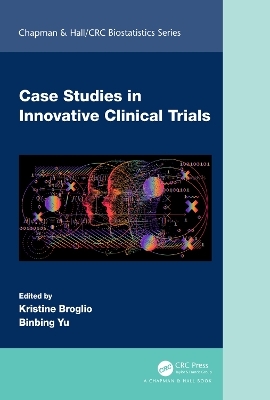
Case Studies in Innovative Clinical Trials
Chapman & Hall/CRC (Verlag)
978-1-032-26265-9 (ISBN)
Drug development is a strictly regulated area. As such, marketing approval of a new drug depends heavily, if not exclusively, on evidence generated from clinical trials. Drug development has seen tremendous innovation in science and technology that has revolutionized the treatment of some diseases. And yet, the statistical design and practical conduct of the clinical trials used to test new therapeutics for safety and efficacy have changed very little over the decades. Our approach to clinical trials is steeped in convention and tradition. The large, fixed, randomized controlled trial methods that have been the gold standard are well understood and expected by many trial stakeholders. However, this approach is not well suited to all aspects of modern drug development and the current competitive landscape. We now see new therapies that target a small fraction of the patient population, rare diseases with high unmet medical needs, and pediatric populations that must wait for years for new drug approvals from the time that therapies are approved in adults. Large randomized clinical trials are at best inefficient and at worst completely infeasible in many modern clinical settings. Advances in technology and data infrastructure call for innovations in clinical trial design.
Despite advances in statistical methods, the availability of information, and computing power, the actual experience with innovative design in clinical trials across industry and academia is limited. This book will be an important showcase of the potential for these innovative designs in modern drug development and will be an important resource to guide those who wish to undertake them for themselves.
This book is ideal for professionals in the pharmaceutical industry and regulatory agencies, but it will also be useful to academic researchers, faculty members, and graduate students in statistics, biostatistics, public health, and epidemiology due to its focus on innovation.
Key Features:
Is written by pharmaceutical industry experts, academic researchers, and regulatory reviewers; this is the first book providing a comprehensive set of case studies related to statistical methodology, implementation, regulatory considerations, and communication of complex innovative trial design
Has a broad appeal to a multitude of readers across academia, industry, and regulatory agencies
Each contribution is a practical case study that can speak to the benefits of an innovative approach but also balance that with the real-life challenges encountered
A complete understanding of what is actually being done in modern clinical trials will broaden the reader’s capabilities and provide examples to first mimic and then customize and expand upon when exploring these ideas on their own
Binbing Yu is a Senior Director in the Oncology Statistical Innovation group at AstraZeneca. He serves as the statistical expert across the whole spectrum of drug R&D, including drug discovery, clinical trials, operation and manufacturing, clinical pharmacology, oncology medical affairs and post-marketing surveillance. He obtained his PhD in Statistics from the George Washington University. His primary research interests are clinical trial design and analysis, cancer epidemiology, observational studies, PKPD modelling and Bayesian analysis. He has published three books on immunogenicity, cure modelling and RWD/RWE. Kristine Broglio is a Statistical Science Director in the Astrazeneca Oncology Statistical Innovation group with interests in adaptive clinical trials and Bayesian statistics. She earned an MS in Biostatistics from the University of Washington and joined the University of Texas M.D. Anderson Cancer Center where she specialized in applied statistical analysis relating to the diagnosis, treatment, and long-term outcomes of breast cancer. Later at Berry Consultants, she led the design, execution, and analysis of well over 100 Bayesian adaptive and complex clinical trials. Ms Broglio is a member of numerous cross-industry working groups through the ASA and DIA and has contributed to over 120 papers to the medical and statistical literature.
1. Review of Advances in Complex Innovative Clinical Trials Part 1. Case Studies in Adaptive Trial Design 2. ANBL1531: The Children’s Oncology Group (COG) Experience using a Bayesian Approach 3. Being SMART about Behavioral Intervention Trials for the Management of Chronic Conditions: Lessons Learned using Sequential Multiple Assignment Randomized Trials (SMARTs) 4. Adapting the Primary Endpoint of TULIP 2 – A Hybrid Bayesian-Frequentist Framework to Incorporate Relevant Information from Prior Studies in Confirmatory Trials in SLE Patients 5. Unblinded Sample Size Re-Estimation: A Case Study. 6. Evaluation of a Method for Sample Size Re-Estimation for a Confirmatory Phase 3 Clinical Trial to Compare Two Test Treatments to Control 7. Hierarchical Composite Endpoints in COVID-19: The DARE-19 Trial Part 2. Case Studies in Other Innovative Clinical Trial Methods 8. Deep Learning Constructed Statistics with Application to Adaptive Designs for Clinical Trials 9. Predicting Phase III Results by Incorporating Historical Data using Bayesian Additive Regression Trees (BART) Extensions 10. Unleashing the Power of Digital Tools in Clinical Trials: A Systematic Review of Digital Measurement Considerations from Implementation Experience 11. Use of Surrogate Endpoints in Clinical Development 12. Advanced Clinical Trial Design that Utilizes Real-World Evidence Part 3. Case Studies in Regulatory and Operational Considerations 13. Case Studies in Statistical Safety 14. Bayesian Dynamic Borrowing and Regulatory Considerations 15. Case Studies in CID and Model-Informed Drug Design (MIDD) Part 4. Case Studies in Collaboration and Communication 16. Project Management in Innovative Clinical Trial Design
| Erscheinungsdatum | 01.12.2023 |
|---|---|
| Reihe/Serie | Chapman & Hall/CRC Biostatistics Series |
| Zusatzinfo | 55 Tables, black and white; 10 Line drawings, color; 49 Line drawings, black and white; 10 Illustrations, color; 49 Illustrations, black and white |
| Sprache | englisch |
| Maße | 178 x 254 mm |
| Gewicht | 720 g |
| Themenwelt | Mathematik / Informatik ► Mathematik |
| Medizin / Pharmazie | |
| Naturwissenschaften ► Biologie | |
| Technik | |
| ISBN-10 | 1-032-26265-6 / 1032262656 |
| ISBN-13 | 978-1-032-26265-9 / 9781032262659 |
| Zustand | Neuware |
| Haben Sie eine Frage zum Produkt? |
aus dem Bereich


